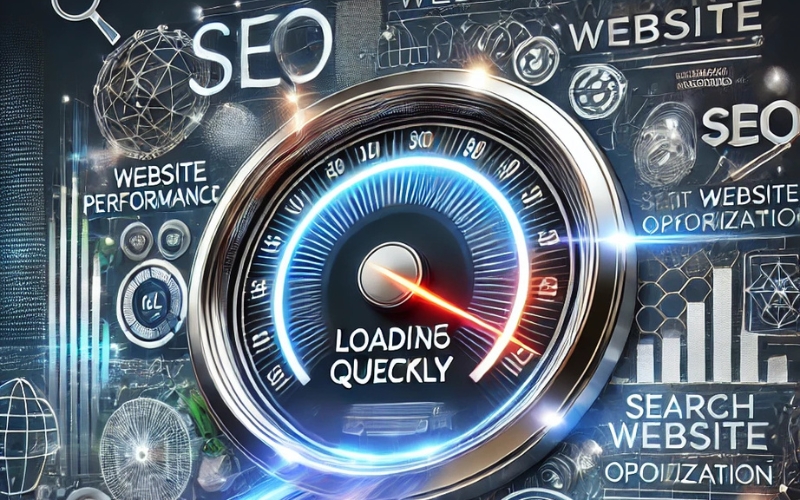In today’s fast-paced digital landscape, website loading speed is a critical factor that can make or break your online presence. Users expect websites to load almost instantly, and search engines prioritize faster sites in their rankings. A slow-loading website not only frustrates visitors but also impacts your SEO performance, bounce rates, and overall conversions. Understanding the importance of speed, the factors that influence it, and the steps you can take to improve it are essential for maintaining a competitive edge in the digital world. This article explores why loading speed matters, the key elements that affect performance, and practical ways to optimize your website for faster results.
Understanding the Importance of Website Loading Speed

In the digital landscape, where competition for user attention is fierce, website loading speed plays a pivotal role. It is no longer a luxury but a necessity to ensure that websites load quickly and efficiently. Whether you’re running an e-commerce platform, a blog, or a corporate website, the speed at which your site loads significantly impacts user experience, search engine rankings, and ultimately, your business success.
Why Website Speed Matters for User Experience and SEO
Website speed directly correlates with user satisfaction. Studies show that users expect a website to load within two to three seconds; anything slower results in frustration and abandonment. A slow-loading website disrupts the browsing experience, making users less likely to explore additional pages or complete desired actions, such as filling out forms or making purchases. On the other hand, a fast-loading site provides a seamless experience, encouraging users to stay longer and engage with your content.
From an SEO perspective, Google and other search engines prioritize websites with faster load times. This preference is rooted in their mission to provide users with the best possible experience. Websites with faster load speeds are rewarded with higher search engine rankings, resulting in increased visibility and organic traffic. Conversely, a sluggish website can hinder your SEO efforts, making it difficult to compete with faster-performing competitors.
The Impact of Slow-Loading Websites on Bounce Rates and Conversions
Bounce rate refers to the percentage of visitors who leave your website after viewing only one page. High bounce rates are a clear indicator that users are dissatisfied with their experience, often due to slow loading times. Research highlights that as page load time increases from one to five seconds, the probability of a bounce increases by 90%. This steep rise underscores the critical importance of maintaining optimal loading speeds.
The repercussions of slow-loading websites extend to conversions as well. Whether your goal is to generate leads, sell products, or increase newsletter signups, a slow website can be a major obstacle. For e-commerce websites, in particular, delays in load time can translate to significant revenue loss. Amazon, for instance, found that just a one-second delay in page load time could cost them $1.6 billion in annual sales. For smaller businesses, the stakes are equally high, as every second lost could mean the difference between gaining or losing a customer.
Overview of Speed Benchmarks and Tools to Test Loading Times
To ensure your website meets user expectations, it’s crucial to understand speed benchmarks. A loading time of under two seconds is considered optimal, while anything beyond three seconds could start to negatively impact user experience and search rankings. Testing your website’s speed regularly is essential to identify performance bottlenecks and implement improvements.
Several tools are available to analyze website speed and provide actionable insights. Google PageSpeed Insights offers a detailed report on your website’s performance and suggestions to enhance loading speed. GTmetrix provides a comprehensive breakdown of load times, page sizes, and areas for optimization. Other tools like Pingdom and WebPageTest allow you to measure speed across various devices and locations, giving you a broader perspective on performance.
By prioritizing website speed and leveraging these insights, you can create a fast, user-friendly experience that drives traffic, enhances engagement, and improves conversions.
Key Factors Affecting Website Loading Speed

Improving website loading speed begins with understanding the key factors that influence it. A website’s performance is affected by various elements, from how it is designed to the infrastructure it operates on. Identifying and addressing these factors is critical for ensuring your website loads quickly and delivers a seamless user experience.
Unoptimized Images: A Leading Cause of Slow Websites
Images are often the largest assets on a webpage and a major culprit behind slow loading times. Using high-resolution images without optimizing them can significantly increase page size, causing delays in loading. For example, uploading a 5MB image for a banner that could be effectively displayed with a 500KB file not only wastes server resources but also frustrates users waiting for the page to load.
Optimization involves reducing image file sizes without compromising quality. Modern formats like WebP are highly efficient, providing superior compression compared to traditional formats like JPEG and PNG. Additionally, implementing responsive image techniques ensures that devices only download the image size required for their screen resolution.
Render-Blocking JavaScript and Large CSS Files
JavaScript and CSS are critical components for website functionality and styling. However, when improperly handled, they can hinder performance. Render-blocking JavaScript refers to scripts that prevent a webpage from being fully loaded until they are executed. This delay negatively impacts how quickly users can view content, resulting in a poor first impression.
Similarly, large CSS files slow down load times due to their size and the time required to parse them. To address these issues, consider minifying and compressing JavaScript and CSS files. Tools like UglifyJS and CSSNano can reduce file sizes by removing unnecessary characters, such as spaces and comments. Additionally, employing asynchronous loading and deferring JavaScript execution can prioritize essential content, ensuring users see the main page elements first.
Hosting Server Performance and CDNs
The performance of your hosting server directly impacts your website’s speed. Shared hosting plans, while cost-effective, often result in slower load times due to shared server resources. Upgrading to a dedicated server or a cloud-based hosting solution can significantly improve performance by providing resources tailored to your website’s needs.
Content Delivery Networks (CDNs) are another powerful tool to boost loading speed. CDNs store copies of your website’s content on servers worldwide, delivering it to users from the nearest location. This minimizes latency and ensures faster load times, particularly for users in geographically distant regions.
The Role of Browser Caching and Third-Party Scripts
Browser caching allows frequently accessed content, such as images and stylesheets, to be stored on users’ devices. This eliminates the need to reload these elements every time the user visits your site, resulting in faster load times. Implementing caching policies, such as setting expiration headers, can improve performance dramatically.
Third-party scripts, like those for analytics, advertisements, or social media widgets, can also slow down your site. Each script adds additional HTTP requests and processing time, which can compound delays. Regularly audit and limit the number of third-party scripts you use. Only include scripts that provide significant value to your website’s functionality or user experience.
By addressing these key factors—unoptimized images, inefficient scripts, hosting performance, and caching—you can effectively improve your website’s loading speed, creating a faster and more engaging experience for your users.
Practical Steps to Boost Your Website’s Speed

Improving your Website Loading Speed is not just a technical necessity but a strategic move to enhance user experience, improve search rankings, and drive conversions. Implementing practical steps to optimize your Website Loading Speed ensures it meets modern web performance standards and delivers a seamless experience to visitors. Here’s a breakdown of the most effective strategies to boost your Website Loading Speed.
Optimize Images with Modern Formats and Compression
Images often account for a significant portion of a website’s loading time. To reduce their impact, optimize images by resizing them to the required dimensions and compressing them without compromising quality. Tools like TinyPNG or ImageOptim can help achieve this. Optimized images play a crucial role in enhancing your Website Loading Speed by reducing unnecessary data transfer.
Modern image formats such as WebP provide superior compression compared to traditional formats like JPEG and PNG while maintaining high quality. Additionally, implement responsive image techniques so that the browser loads images in sizes appropriate to the user’s device, further improving your Website Loading Speed.
Minify CSS, JavaScript, and HTML Files
Minification is the process of removing unnecessary characters such as spaces, line breaks, and comments from your CSS, JavaScript, and HTML files. These elements may not be visible to users but can significantly bloat file sizes, directly impacting your Website Loading Speed. Tools like UglifyJS, CSSNano, and HTMLMinifier can automatically minify your code, reducing load times and improving overall Website Loading Speed.
Another effective strategy is bundling, which combines multiple CSS or JavaScript files into one. This reduces the number of HTTP requests made to the server, speeding up the loading process and boosting your Website Loading Speed. For JavaScript, consider using asynchronous loading or deferring scripts to ensure non-critical scripts load after the main content.
Leverage Content Delivery Networks (CDNs)
A Content Delivery Network (CDN) is a system of distributed servers that store cached versions of your website content. When a user visits your site, the CDN delivers content from the server closest to their location, reducing latency and improving your Website Loading Speed.
CDNs are particularly effective for websites with a global audience. Services like Cloudflare, Amazon CloudFront, and Akamai not only improve Website Loading Speed but also enhance security by mitigating DDoS attacks and providing SSL encryption.
Enable Lazy Loading for Media
Lazy loading is a technique that defers the loading of non-essential content, such as images and videos, until it is needed. For example, an image below the fold won’t load until the user scrolls to that section of the page. This significantly reduces the initial page load time, improving your Website Loading Speed and ensuring faster access to above-the-fold content.
Most modern web development frameworks and platforms, including WordPress, offer built-in lazy loading capabilities or plugins like LazyLoad by WP Rocket to simplify implementation. Enabling lazy loading is a simple yet effective way to optimize your Website Loading Speed.
Improve Server Response Time
The time it takes for a server to respond to a user’s request can significantly affect your Website Loading Speed. To improve server response time:
- Upgrade to a faster hosting plan, such as a dedicated server or cloud hosting.
- Use caching mechanisms like server-side caching or tools such as Redis or Memcached.
- Optimize your database by removing unnecessary data and queries.
By optimizing images, minifying files, leveraging CDNs, enabling lazy loading, and improving server response times, you can significantly enhance your Website Loading Speed. These practical steps ensure that your website not only performs better but also provides a positive experience for users and meets modern web standards. Implement these strategies today to enjoy faster load times and better engagement, all while prioritizing your Website Loading Speed.
Conclusion
Website loading speed is more than a technical concern; it is a fundamental aspect of user experience and online success. By understanding its significance, addressing common performance bottlenecks, and implementing optimization techniques, you can create a website that is fast, efficient, and user-friendly. Optimized images, streamlined code, CDNs, and lazy loading are just a few strategies that can transform your site’s performance. A faster website not only improves user satisfaction and engagement but also enhances your search rankings and drives conversions. Take the time to prioritize loading speed and reap the benefits of a high-performing website in today’s competitive digital environment.

